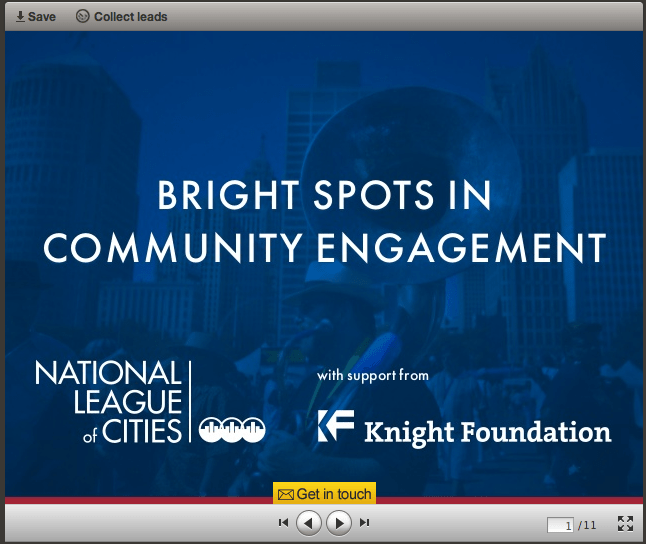
Bright Spots in Community Engagement: Detroit – the wild, wired west
The following is part of blog series highlighting communities profiled in “Bright Spots in Community Engagement,” a report authored by the National League of Cities with support from Knight Foundation. It is written by Matt Leighninger, executive director of the Deliberative Democracy Consortium. It originally appeared on the National League of Cities’ blog citiesspeak.org. Related blog posts include in-depth looks at Philadelphia, Detroit, Macon, Ga. and Charlotte N.C. Photo credit: Detroit Soup.
When you talk to civic entrepreneurs in Detroit, you hear a common refrain: “This city is like the Wild West – you can do anything here!”
Part of Detroit’s ‘Wild West’ feeling comes from the physical surroundings. Even though it is an older Rust Belt city, the wide avenues in the downtown and the new wide-open spaces in Detroit’s neighborhoods – which have emerged in part through demolition of blighted housing – make it seem emptier than is actually the case. In fact, Detroit has greater population density than Denver or Phoenix. RELATED LINKS

Some people mention the coyotes that have moved into neighborhoods near downtown; Delphia Simmons of Kiva Detroit complains about the pheasants that now occupy the vacant lot next to her house and wake her up early in the morning with their calls.
The support of several foundations, including Knight Foundation, combined with the wide-open environment for civic entrepreneurs, has fostered a number of bright spots in Detroit’s engagement scene:
- Kiva Detroit, which provides microloans to local small businesses.
- Hatch Detroit, which provides funding, business services and community exposure to new retail startups.
- Code for America; Detroit is one of the cities involved in this national initiative to connect technology experts with public service through a system of embedded fellowships.
- Detroit Works, a community engagement process to create a shared, achievable vision for Detroit’s future.
- Detroit Soup, a monthly dinner at which participants raise money and select creative projects to receive micro-financing.
- Model D, an online magazine highlighting the successes of engagement efforts.
- Urban Innovation Exchange, an initiative to showcase and advance Detroit’s growing civic and social innovation movement.
- Data Driven Detroit, which provides high quality information and analysis to drive engagement and informed decision-making.
- The Detroit City Futbol League/Club, an 800-person, 28-neighborhood league that goes beyond soccer to bring together neighbors and highlight Detroit’s unique and historic communities.
Most of these bright spots rely on the same successful principles. Similar to the community engagement work being done in Philadelphia, all of them build supportive networks of people, and use social media in concert with face-to-face meetings to make and sustain those connections. They are all information and idea rich, allowing innovation to spread rapidly and gather support through the network. And they have a ‘cool factor’ – there is a psychological reward for people in these networks when they do things that seem innovative and public-minded.
The public institutions of Detroit do not seem to have much of a presence in these networks. Nick Gorga of Hatch Detroit, a nonprofit committed to promoting retail entrepreneurs and improving retail business in Detroit, reported that though he and his partners had spoken with hundreds of people as they set up their organization, they hadn’t talked with a single person in local government.
Sean Mann, founder of the Detroit City Futbol League, noted that most of the successes he and his collaborators have experienced have come in spite of, rather than with the support of, city government institutions.
Bridging Civic Divides
One result of this division between civic entrepreneurs and civic institutions is a lack of coordination among people working to solve public problems. The new civic networks have been effective at tapping assets outside government, but they are not connected with the public resources, including money and manpower, available for problem-solving and community building.
A largely unspoken dimension of this division is racial: the civic entrepreneurs working in Detroit seem to be disproportionately white, well-educated, and middle to upper-income, whereas the workforce in City Hall and the Detroit Public Schools is dominated by the African America middle class.
The real Wild West may have been a good environment for innovation, but it was also a highly divided society. There may be ways that technology assisted, socially savvy network building can help to bridge the key divisions in Detroit, making it a city that is more innovative, equitable and engaged. Public-private partnerships between civic entrepreneurs, foundations, city government and other public institutions could provide a more systematic, coordinated approach to community engagement that is as inclusive as it is innovative.
By Matt Leighninger, executive director of the Deliberative Democracy Consortium
Related webinar: “How Civic Entrepreneurship is Re-Energizing Detroit: Lessons Learned from the Field“
Recent Content
-
Community Impactarticle ·
-
Community Impactarticle ·
-
Community Impactarticle ·


